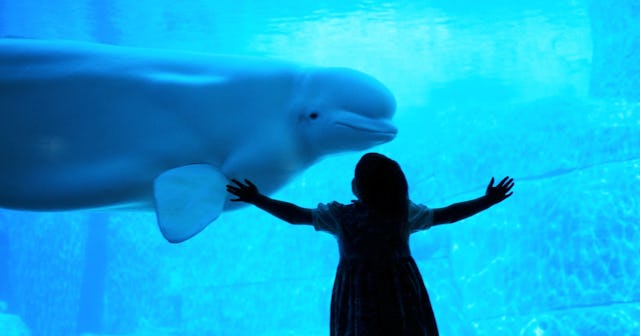11 Whale Coloring Pages Sure To Create A Splash During Art Class

For being some of the biggest creatures — not just in the ocean, but in all of existence — these seemingly “gentle giants” don’t get enough love, if you ask us. Make no mistake: It’s impressive (albeit a bit terrifying!) when someone swims in the water with sharks. However, swimming with whales is truly next-level. There are whales so massive that humans are the equivalent of a fly or spider to them! The largest animal on Earth, the Arctic Blue Whale, can weigh as much as 173 tons. That equals out to the weight of more than four semi-trucks. Wowza, right? And just as awe-inspiring as they are in size, these majestic creatures are awe-inspiring in beauty, too — making whale coloring pages a seriously scenic activity for kids. Bottom line: Whales are big on fun.
Just make sure you emphasize to your little ones that most whales (like sharks, actually) mean no harm at all. Humpback whales don’t even feed for five to six months out of the year. Instead, they survive off stored up fat. If you’ve ever seen one in person, you know how magnificent they are to encounter. (Uh, unless one surfaces under your kayak.) Even if whales don’t immediately spring to mind when someone asks your favorite animal, we have some interesting facts about them that just might make you change your mind.
So, go ahead. Print out these coloring pages. While your kiddos practice self-regulation, their pencil grip, and their hand-eye coordination, you can teach them a ton (see what we did there?) of fascinating whale tidbits. Who knows? Maybe we’ll make a whale-lover out of one or two of them.
Whale No. 1
Did you know there are two main kinds of whales? The two different types are toothed and baleen. Toothed whales, as their name implies, have teeth. Baleen whales have something more like plates or sheets that people often think look like bristles. These help them sieve their dinners.
Whale No. 2
The blowhole atop a whale’s head isn’t just there to make them look extra cute. Whales are mammals and breathe air, just like us! The blowhole helps them, in essence, exhale. Fun fact: Blue whales have one of the loudest voices on Earth. They’re even noisier than a jet engine! And here’s an even funnier fact: The closest living relative of whales are hippos.
Whale No. 3
This guy looks like he moves pretty slow, right? It’s all relative. For short bursts, most whales can reach speeds around 30 miles per hour. Typically, however, they cruise at about 12 miles an hour. That’s still faster than most of us ride our bikes! Alas, even as majestically as whales move, the ancient Greeks thought they were sea monsters. When sailors saw the backs of a group of whales, they assumed it belonged to one giant sea serpent.
Whale No. 4
Did you know whales can stay underwater for about 90 minutes at a time? We can’t even do 90 seconds. Most feeding dives, however, only last about 30 to 40 minutes. You can color this big guy blue to make him a blue whale. While filling it in, ponder the fact that there used to be more than 250,000 blue whales in the ocean. But, in the 1900s, they were aggressively hunted and their population was reduced by more than 99 percent. Between 1904 to 1967, more than 350,000 blue whales were killed. Yet another reason marine conservation is so vital!
Whale No. 5
Much like dads when watching a football game, whales don’t fully “sleep.” Instead, one hemisphere (or “half”) of their brain sleeps at a time. It’s believed that if a whale truly fell entirely asleep, it would most likely drown.
Whale No. 6
Most female whales only have one calf every two to three years. Their gestation period lasts almost a year, so they probably need extra time to recover. Like any good mama, this whale is taking all the proper precautions necessary to protect her and any calf she may be carrying.
Whale No. 7
While they’re typically much bigger than a baby cow, newborn whales are also referred to as “calves.” You might think this little fella is going to gobble down tons of food to grow big and strong. So, it’ll probably surprise you to learn that whales don’t eat year-round. For about half a year, they don’t eat anything. Instead, they use the time to travel to the equator to mate.
Whale No. 8
Next time someone calls you a “helicopter mom,” just tell them you prefer the term “whale mom.” Whale calves nurse for at least a year and remain nearly attached to their mothers for quite a long time while learning to survive and hunt.
Whale No. 9
Whales have surprisingly complicated and deep personalities. They don’t just eat and “sleep” but are known to socialize and scheme together. They even grieve. Whales have super complex brains that make them smarter than the average animal, and incredibly emotional, too. Did we mention they also have pretty impressive endurance? Gray whales complete one of the longest annual migrations of any mammal, traveling roughly 10,000 miles round trip.
Whale No. 10
Maori cosmology views whales as sacred and supernatural animals — believed to be descendants of Tangaroa, the ocean god.
Whale No. 11
This big fella looks like he’s waving hello! Fun fact: Sei whales release about 166 gallons of urine a day. And if you thought that was a lot, a fin whale excretes around 250 gallons daily.
Click here to print all of the whale coloring pages at once!
This article was originally published on